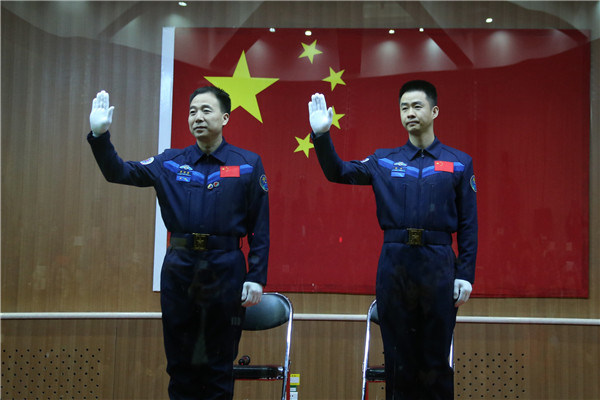
Chinese astronauts Jing Haipeng (L) and Chen Dong meet the media at a press conference at the Jiuquan Satellite Launch Center in northwest China, Oct 16, 2016. The two male astronauts will carry out the Shenzhou-11 mission. The Shenzhou-11 manned spacecraft will be launched at 7:30 am Oct 17, 2016 Beijing Time (2330 GMT Oct. 16). [Photo/Xinhua]
JIUQUAN — The Shenzhou-11 manned spacecraft will be launched at 7:30 am Beijing Time, Oct 17, China’s manned space program spokesperson said on Oct 16.
The spaceship will take two male astronauts Jing Haipeng and Chen Dong into space, said Wu Ping, deputy director of China’s the manned space engineering office, at a press conference at the Jiuquan Satellite Launch Center.
The mission will be carried out with a Long March-2F carrier rocket, Wu said.
The spacecraft will dock with orbiting space lab Tiangong-2 within two days, and the astronauts will stay in the space lab for 30 days, she said.
After that the Shenzhou-11 spaceship will separate with Tiangong-2 and return to Earth within one day, Wu said.
The mission aims to transport personnel and materials between Earth and Tiangong-2, and examine rendezvous, docking and return technologies.
During the mission, the spacecraft will form a complex with Tiangong-2. The complex’s capabilities of supporting astronauts’ life, work and health, and astronauts’ abilities for carrying out flight missions will be tested, Wu said.
Other objectives include conducting aerospace medical experiments, space science experiments and in-orbit maintenance with human participation, along with activities to popularize scientific knowledge, she added.
Several technical alterations have been made to Shenzhou-11, though its main functions and technical parameters remain basically the same with Shenzhou-10, Wu said.
To meet the needs of this mission, the orbit control strategy and flight procedures have been adjusted to adapt Shenzhou-11 to the change of the rendezvous, docking and return orbit from 343 kilometers to 393 kilometers from Earth.
The layout of cargo loading has been adjusted to enhance transportation capabilities for the mission.
To further improve the spacecraft’s reliability and astronauts’ safety, wide-beam relay telecommunications devices have been equipped, which will significantly expand the scope of telemetry, tracking and control, as well as improve the space-ground communication support capabilities when the posture of the spacecraft is changing rapidly.
To verify future space technologies and meet the demand for prolonging the service life of rendezvous, telemetry and tracking devices in future space stations, such devices in Shenzhou-11 have been upgraded, according to Wu.
Certain technical alterations have also been made to the carrier rocket, she said.
Tiangong-2 has been maneuvered into a near circular orbit 393 kilometers from Earth, where it will rendezvous and dock with Shenzhou-11, Wu said, adding Tiangong-2 is now “ready.”
Launched on Sept 15, Tiangong-2 has been orbiting for a little more than one month, and remained “in a good condition,” with subsystems and equipment operating normally, Wu said.
Since Tiangong-2 entered orbit, its payload equipment has completed self-inspection and initial configuration, and space experiments, since Sept 22, have been carried out as planned and produced results.
“According to in-orbit testing and experimental data, Tiangong-2 has delivered the desired results. The ‘report card’ is satisfactory,” Wu said.
Since China initiated the manned space program, she said, it has signed a number of cooperation deals with space agencies of many countries and international organizations.
In the future, China will continue to actively pursue international exchanges and cooperation in equipment development, space application, training of astronauts, joint flights and aerospace medicine, and share the fruits of China’s manned space efforts with other countries, she added.
“Shenzhou-11 is a new beginning. It marks the imminent end to the exploratory stage of China’s manned space program,” said Zhang Yulin, deputy commander-in-chief of China’s manned space program.
With the establishment of its own space station, which is expected around 2020, China will carry out manned space missions on a regular basis, with spacecraft launched several times a year, instead of once every several years, said Zhang, also deputy chief of the armament development department of the Central Military Commission.
Besides astronauts, engineers and even tourists will then hopefully go to space, Zhang added.
